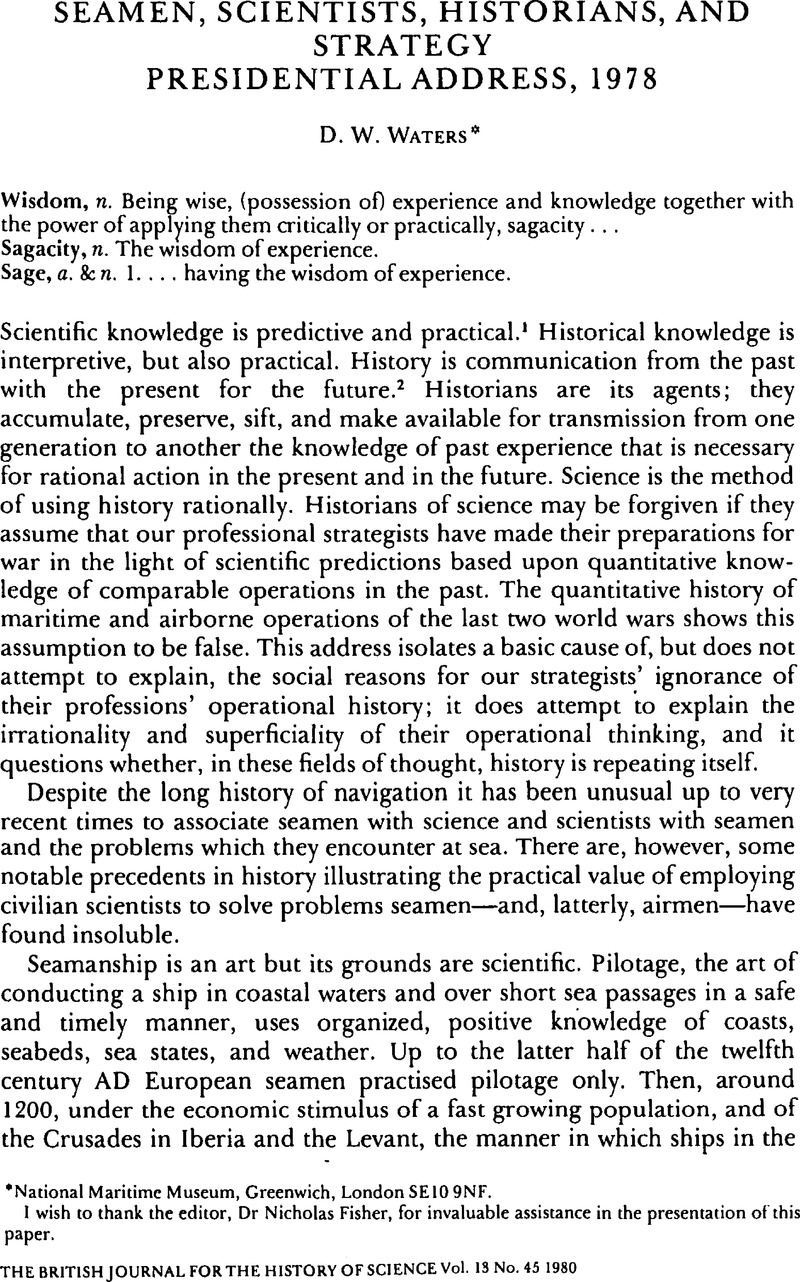Article contents
Seamen, Scientists, Historians, and Strategy: Presidential Address, 1978
Published online by Cambridge University Press: 05 January 2009
Abstract

- Type
- Presidential Address
- Information
- The British Journal for the History of Science , Volume 13 , Issue 3 , November 1980 , pp. 189 - 210
- Copyright
- Copyright © British Society for the History of Science 1980
References
NOTES
I wish to thank the editor, Dr Nicholas Fisher, for invaluable assistance in the presentation of this paper.
1 Bronowski, J., The visionary eye, Cambridge, Mass. & London, 1979, p. 59.Google Scholar
2 Personal communication from DrMichaelis, A. R., editor of Interdisciplinary science review, c1978.Google Scholar
3 Lane, F. C., ‘The ecomonic meaning of the invention of the compass’, American historical review, 1963, 68, 605–17.CrossRefGoogle Scholar
4 Taylor, E. G. R., ‘Mathematics and the navigator in the thirteenth century’, Journal of the (Royal) Institute of Navigation, 1960, 13, 1–12.CrossRefGoogle Scholar
5 These were the first scale drawings constructed in Europe since classical times. Ptolemaic maps were of course the first scale drawings, but these were unknown in the west until the early fifteenth century. The first architectural drawings to scale were devised early in the fifteenth century, probably by Brunelleschi; see Pacey, A. J., The maze of ingenuity, London, 1974, p. 97.Google Scholar
6 Ruddock, A. A., Italian merchants and shipping in Southampton, 1270–1600, Southampton, 1951, pp. 19–21.Google Scholar
7 Waters, D. W., Science and the techniques of navigation in the renaissance, Greenwich, 1976Google Scholar, contains exhaustive references.
8 Maskelyne, N., The British mariner's guide, London, 1763, ‘Introduction’.Google Scholar
9 Waters, D. W., ‘The philosophy and conduct of maritime war, 1815–1945’, Journal of the Royal Naval Scientific Service, 1958, 13, 109–19, 183–92.Google Scholar
10 Waters, D. W., ‘The science of Admiralty, iv: Convoy in the age of sail, 1204–1874’, The naval review, 1964, 52, 179–94.Google Scholar
11 Waters, D. W., ‘The science of Admiralty, vi’Google Scholar, ibid., pp. 423–37 (423).
12 Toulmin, S. and Goodfield, J., The fabric of the heavens, London, 1963, p. 201.Google Scholar
13 It was not until many years after I had left the Admiralty that I read Whitehead, A. N., Science in the modern world, London, 1925Google Scholar (reprinted with a preface by Young, J. Z., London, 1975Google Scholar). His discussion of recurrence and periodicity (reprint, pp. 45–6) indirectly illuminates this aspect of operations.
14 Shakespeare, William, Richard II, I, iii, 275.Google Scholar
15 Waters, , op. cit. (10), pp. 185–6.Google Scholar
16 Waters, , op. cit. (9), pp. 109–13.Google Scholar
17 In Science and the modern world, Whitehead observed, ‘There is an error … of mistaking the abstract for the concrete. It is an example of … the fallacy of misplaced concreteness. This fallacy is the occasion of great confusion in philosophy’. Whitehead was referring to cosmological philosophy. The use of the terms ‘sea routes’ or ‘supply lines’ in place of the word ‘ships’ in the philosophy of war is a classical example of ‘the fallacy of misplaced concreteness’. Unlike ships which are concrete realities, ‘sea routes’ and ‘supply lines’ are figments of the imagination, they cannot be sunk nor can they deliver any supplies. The consequences of the great confusion that ensued illustrates precisely the truth that Professor Young states in his preface to Whitehead's study: ‘Once we have given a name to some abstract entity or quality we tend to apply to it the same grammatical treatment as we should give an object that could be seen and touched’; Whitehead, , op. cit. (13, reprint), pp. 7, 68Google Scholar. See Figs. 1 and 2 in the text above.
18 ‘Misplaced concreteness’ in relation to aircraft, e.g., the use of ‘air power’ instead of ‘aircraft’, has confused strategic thought in Britain and America with grave consequences. In many influential strategists' imaginings ‘air power’ was to do (and still does) things which it was (and is) demonstrably impossible for aircraft and aircrews to do within the limitations imposed upon their activities in war by the parameters of their operational performance and training. A classic example of this is embodied in the expectations, miscalculations, and realities of the British ‘strategic bombing’ in the second world war; see Blackett, P. M. S., ‘Operational research: recollections of problems studied, 1940–1945’, in Brassey's annual: the armed forces year-book 1953, London, 1953, pp. 88–106Google Scholar; and the officially compiled quantitative Strategic bombing surveys of the European and Pacific theatres, printed in 1945 but still, I believe, unpublished in this country.
19 Waters, D. W., ‘The mathematics of convoy’, Navy international, 05 1978, pp. 22ff.Google Scholar
20 Blackett, , op. cit. (18), especially pp. 102–6.Google Scholar
21 Waters, D. W., ‘The science of Admiralty, i and ii’, The naval review, 1963, 51, 395–402 (399–401).Google Scholar
22 Ibid.; and ‘The science of Admiralty, iii’, ibid., 1964, 52, 15–26; ‘iv’, 179–94; V, 291–309; ‘vi’, 423–37. For the responsibility of the Air Ministry for maritime aircraft, see Waters, , op. cit. (9), p. 183.Google Scholar
23 ‘The really vital problems were found by the operational research groups themselves, rather than given them to solve by the Service operational staffs’; Blackett, , op. cit. (18), p. 106.Google Scholar
24 I Corinthians, XIII, 12.Google Scholar
25 Ecclesiastes, I, 9Google Scholar. See Figs. 4 and 5.
26 As Whitehead so lucidly put it, ‘The originality of mathematics consists in the fact that in mathematical science connections between things are exhibited which, apart from the agency of the human reason, are extremely unobvious’; op. cit. (13), p. 32.Google Scholar
- 2
- Cited by




